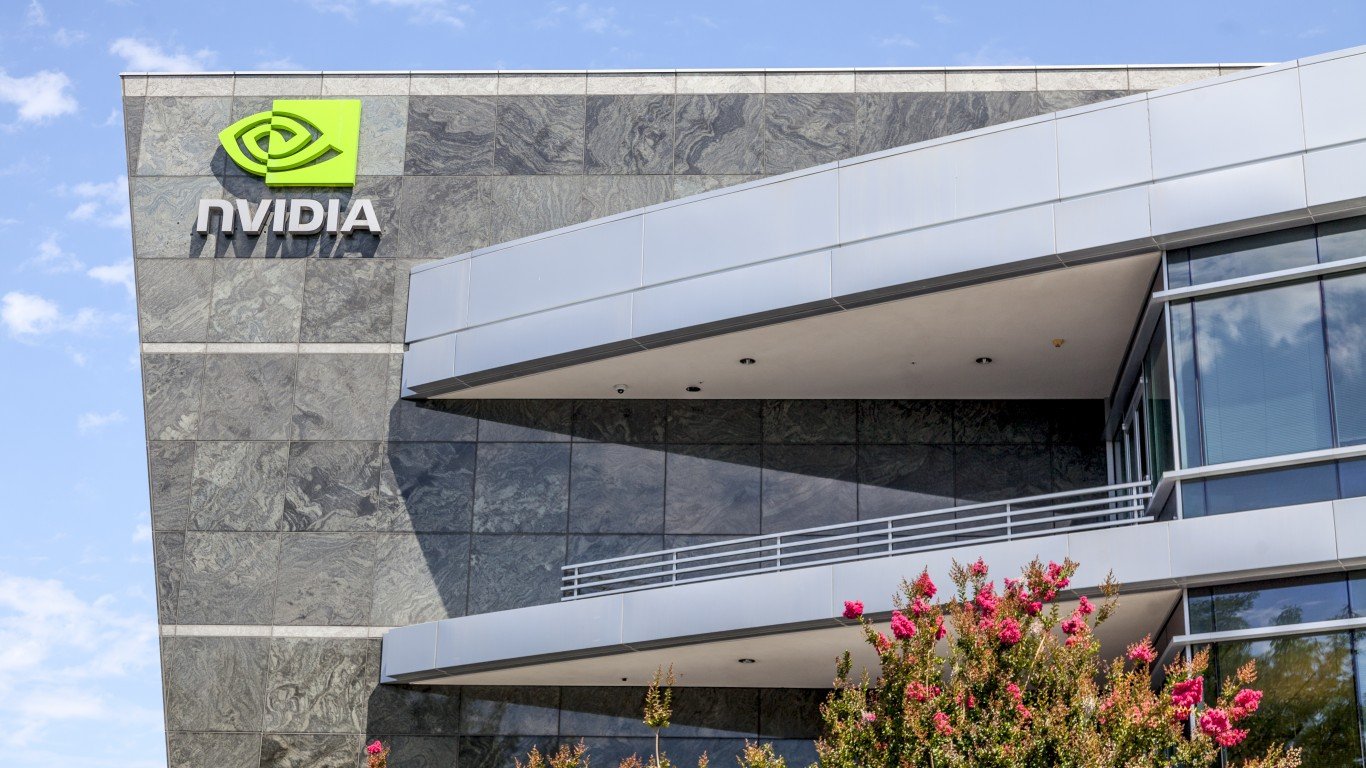

Among U.S. stocks based on valuation metrics like share price to free cash flow, Nvidia Corp. (NASDAQ: NVDA) is one of the most overvalued stocks investors can buy. On stock performance metrics like share price changes, Nvidia is among the best, both on year-to-date and 12-month increases. And even though the company barely pays a dividend, its total return to shareholders is also among the highest. Anyone who bought and held Nvidia stock for 10 years has gained nearly 9,200% on that investment. That is $9.2 million for every $1,000 investment.
[in-text-ad]
Since late February, the shares are up more than 50%. That gain is due in large part to the company’s position as a principal supplier of semiconductors to meet the demand for generative artificial intelligence (AI) applications. Last Friday, industry news source Wccftech reported that Nvidia’s A800, a year-old version of the company’s A100 server designed to dodge U.S. sanctions on sales of the latest technology to China, is selling for $36,500 and can barely keep up with demand.
Two weeks ago, Google introduced its A3 Supercomputer, capable of delivering 26 exaflops of AI performance. That is a nearly unimaginable 26 quintillion floating point operations per second. Industry website Tom’s Hardware said this:
Each A3 supercomputer is packed with 4th generation Intel Xeon Scalable processors backed by 2TB [terabytes] of DDR5-4800 memory. But the real “brains” of the operation come from the eight Nvidia H100 “Hopper” GPUs [graphics processing units], which have access to 3.6 TBps [TB per second] of bisectional bandwidth by leveraging NVLink 4.0 and NVSwitch.
Hopper GPU cards with 80 GB of memory were recently listed on eBay for prices ranging from $40,000 to $46,000. The Hopper chip itself costs around $10,000.
So why is the stock not climbing as it prepares to report quarterly earnings after U.S. markets close Wednesday? Put options sales have far outstripped call options purchases for the past week as options traders probably look to take some profit by selling now and purchasing again after Nvidia reports results.
Sales estimates for the 2024 fiscal year ending in January have remained right around $30 billion since late February. If Nvidia can beat first-quarter revenue estimates, and if it raises guidance, the shares will get another boost. Options traders will look like geniuses. Of course, a miss or downside guidance could have the opposite effect, but even in the unlikely event that such a surprise occurs, most investors are likely to treat the dip as an invitation to buy more Nvidia stock at a nice discount.
Let’s look at what the consensus estimates are predicting.
There are 48 brokerages covering Nvidia stock. Of those, 37 have a Buy or Strong Buy rating. The other 11 have Hold ratings. Shares already trade above the median price target of $300.00 and have an upside potential of 20.2% to the high price target of $375.00.
For Nvidia’s first quarter of fiscal 2024, analysts expect revenue of $6.52 billion, which would be up 7.7% sequentially but down 21.4% year over year. Adjusted earnings per share (EPS) are forecast to rise by about 4.1% sequentially to $0.92, a drop of 32.4% year over year. For the full 2024 fiscal year January, ending next January, analysts estimate EPS of $4.55, up 36.2%, and revenue of $30.07 billion, up 11.5%.
Nvidia stock trades at 68.5 times expected 2024 EPS, 50.4 times estimated 2025 earnings of $6.19 and 39 times estimated 2026 EPS of $8.00 per share. Its 52-week trading range is $108.13 to $318.28. Nvidia pays an annual dividend of $0.16 (yield of 0.05%). Total shareholder return for the past 12 months was 86.09%.
At Tuesday’s opening bell, Nvidia stock traded down about 0.3% at around $311.00. The Nasdaq Composite was down 0.37%.
Take This Retirement Quiz To Get Matched With A Financial Advisor (Sponsored)
Take the quiz below to get matched with a financial advisor today.
Each advisor has been vetted by SmartAsset and is held to a fiduciary standard to act in your best interests.
Here’s how it works:
1. Answer SmartAsset advisor match quiz
2. Review your pre-screened matches at your leisure. Check out the
advisors’ profiles.
3. Speak with advisors at no cost to you. Have an introductory call on the phone or introduction in person and choose whom to work with in the future
Take the retirement quiz right here.
Thank you for reading! Have some feedback for us?
Contact the 24/7 Wall St. editorial team.
 24/7 Wall St.
24/7 Wall St.


